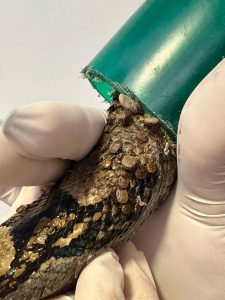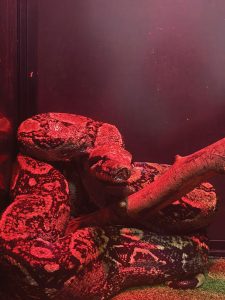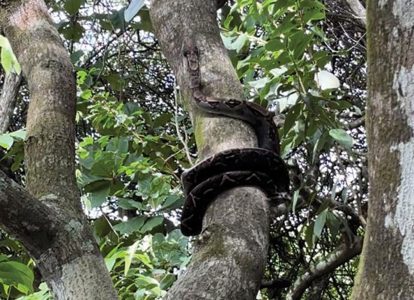A Translocation That Ended in Rescue
 In a recent event where the firefighters of the area took a boa out of a home to relocate it in the Manuel Antonio National Park. SINAC officials in Manuel Antonio, noticed that something was not right and worried about the physical condition of the animal, quickly coordinated the transfer to the Rescue Center Kids Saving the Rainforest.
In a recent event where the firefighters of the area took a boa out of a home to relocate it in the Manuel Antonio National Park. SINAC officials in Manuel Antonio, noticed that something was not right and worried about the physical condition of the animal, quickly coordinated the transfer to the Rescue Center Kids Saving the Rainforest.
The reptile, approximately 1.80 meters long, showed severe signs Of dehydration and an alarming amount of ticks attached to it’s skin. At the Rescue Center, veterinarians confirmed the severity of it’s condition and called him Patroclo.
 The Veterinary Team carefully examined the boa and one by one they removed the ticks using special techniques so as not to produce additional damage to the skin of the reptile. Also, they administered fluids subcutaneously to combat dehydration. The treatment also included the constant monitoring of its general condition and an adequate diet to regain strength.
The Veterinary Team carefully examined the boa and one by one they removed the ticks using special techniques so as not to produce additional damage to the skin of the reptile. Also, they administered fluids subcutaneously to combat dehydration. The treatment also included the constant monitoring of its general condition and an adequate diet to regain strength.
This week, after finishing his treatment and recovery, Patroclo has been liberated back to its natural habitat. The release was carried out in a protected area, far from human activities, to ensure his well-being and minimize the risk of future infestations.
We hope that our story inspires more people to value and protect the biodiversity of the fauna in this country.
 This rescue and release underlines the importance of conservation and a need to protect the natural ecosystems. Rescue centers play a crucial role in the rehabilitation of endangered animals and in educating the public about the need to respect and preserve wildlife. While the boa continues his life in nature, his story serves as a powerful reminder of the positive impact we can have when we work together to take care of our environment.
This rescue and release underlines the importance of conservation and a need to protect the natural ecosystems. Rescue centers play a crucial role in the rehabilitation of endangered animals and in educating the public about the need to respect and preserve wildlife. While the boa continues his life in nature, his story serves as a powerful reminder of the positive impact we can have when we work together to take care of our environment.
 Boas (Boa imperator) are a species recognized for their important role in the ecosystem as controllers of rodent and other populations of small mammals. Despite their intimidating appearance, they are not poisonous and rarely represent a danger to humans. These snakes are experts in camouflage, using the patterns of their skin to mix with the environment and surprise their prey. They can measure up to four meters long and live more than 20 years. Although many people believe that all snakes lay eggs,however the Boa imperator does not. They are ovoviviparous. This means that the females retain the eggs inside their bodies until the offspring are ready to be born, giving birth to live offspring instead of laying eggs.
Boas (Boa imperator) are a species recognized for their important role in the ecosystem as controllers of rodent and other populations of small mammals. Despite their intimidating appearance, they are not poisonous and rarely represent a danger to humans. These snakes are experts in camouflage, using the patterns of their skin to mix with the environment and surprise their prey. They can measure up to four meters long and live more than 20 years. Although many people believe that all snakes lay eggs,however the Boa imperator does not. They are ovoviviparous. This means that the females retain the eggs inside their bodies until the offspring are ready to be born, giving birth to live offspring instead of laying eggs.
Why can they have parasites?
The case of this boa with ticks is not unusual. Snakes can be susceptible to infestations of external parasites such as ticks, especially when they are weakened or injured. If it is not treated properly, a very high load of these parasites can lead to infections and other diseases.
 The causes of the infestation may vary. Often, ticks are found in humid and warm environments. In addition, when a snake is sick or malnourished, their immune system weakens, making them more prone to these attacks. Interaction with domestic animals or invasion of natural habitats by human activities can also increase the exposures to these parasites.
The causes of the infestation may vary. Often, ticks are found in humid and warm environments. In addition, when a snake is sick or malnourished, their immune system weakens, making them more prone to these attacks. Interaction with domestic animals or invasion of natural habitats by human activities can also increase the exposures to these parasites.
The rescue of this boa is a reminder of the importance of protecting and conserving wildlife. Rescue centers play a key role in the rehabilitation of endangered animals and in public education about the importance of respecting and preserving natural ecosystems. This incident is an example of the need for responsible practices that minimize the impact of humans in the local fauna and promote a healthy environment for all species.
